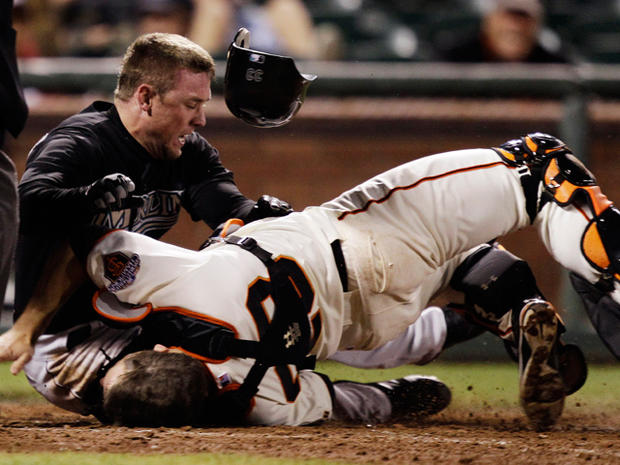Posey injury stirs debate on collisions at plate
The Giants' chances of repeating as World Series champs took a crushing blow when their star catcher Buster Posey broke his leg in a violent collision at home plate Wednesday night.
The injury also stirred a debate about whether Major League Baseball needs to alter the rules to better protect catchers in such instances.
In the play, the Marlins' Scott Cousins tagged from third base on a sacrifice fly, beating the throw home and lowering his shoulder to slam into Posey for a clean hit on the reigning NL Rookie of the Year.
Buster Posey breaks leg, may be out for year
"You just don't replace a guy like Buster Posey," said Giants Manager Bruce Bochy, a former catcher who was so upset by the news that he called on Major League Baseball to review rule changes for collisions at the plate.
However, another former catcher - one who was famously flattened in the final play of the 1970 All-Star game - says the rules should not be touched.
Ray Fosse, whose career was detoured when he was decked by Pete Rose at home plate in that game, told the San Francisco Chronicle that he feels for Posey and thinks the collision was "unnecessary" - but doesn't think MLB should change a thing.
"The game has been around more than 100 years, and now they're going to start protecting catchers? I can't see anything that can be changed," Fosse told the Chronicle. "In high school, you can't run over a catcher. But that's high school. This is professional baseball. The idea is to score runs. If the catcher has the ball and he's standing there, the runner has to stop? Is that the protection? I can't believe anything can be done, and I don't see how you could regulate something like that."
The rule protecting infielders - you can't, for example, steamroll a third-baseman to jar the ball loose - could be applied to catchers. But it's hard to see MLB changing the rule since 1) serious injuries at home plate are very rare and 2) the bang-bang collision is arguably one of the most exciting plays in sports.
But it's also one of the most violent - in any sport. According to ESPN's Sport Science, a base runner is clocking 18 mph by the time he reaches the catcher. Applying Newton's third law of motion, the Sports Science guys calculate that the resulting collision generates 3,215 pounds of force. That impact is stronger than a blindside hit by Colts' star pass rusher Dwight Freeney.
It's amazing to think that Scott Cousins could inflict more damage than Dwight Freeney. But it's equally surprising that 3,215 pounds of force hasn't left even more catchers with fractured bones.
